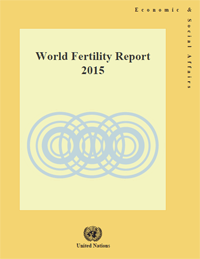 The World Fertility Report 2015, the sixth in a series, complements and supplements previous publications by providing a more comprehensive overview of the estimates and projections of fertility levels and trends with a particular focus on changes of fertility levels from 1970-1975 to 2010-2015, and on fertility projections from 2010-2015 to 2045-2050. More emphasis than before is given in this report to the analysis of fertility transitions. The discussion of changes in fertility and age patterns of childbearing at the regional level and for individual countries is supplemented with an extensive set of annex plots.
The World Fertility Report 2015, the sixth in a series, complements and supplements previous publications by providing a more comprehensive overview of the estimates and projections of fertility levels and trends with a particular focus on changes of fertility levels from 1970-1975 to 2010-2015, and on fertility projections from 2010-2015 to 2045-2050. More emphasis than before is given in this report to the analysis of fertility transitions. The discussion of changes in fertility and age patterns of childbearing at the regional level and for individual countries is supplemented with an extensive set of annex plots.
The report also presents an in-depth analysis of past, present and projected levels and trends of adolescent fertility at the global, regional as well as national levels, an SDG indicator 3.7.2.
The report further extends previous publications by quantifying the effect of fertility on population growth over the period 2010-2050, with a focus on those countries where fertility is the main driving factor behind population growth or decline.
Finally, the report includes a chapter on empirical data sources and methods for fertility estimation to address the call of the 2030 Sustainable Development Agenda for strengthening data production and the use of better data in policymaking and monitoring. Drawing on a recently established database of empirical fertility data, the World Fertility Data 2015 , this report provides, for the first time, estimates of gaps and timeliness in the empirical fertility data used as a basis for producing estimates of fertility levels and trends.
Report
Annex Table 1. Details of fertility transition classifications of countries and areas
Annex figures
- Annex Figure 1. Total fertility, 1970-1975 and 2010-2015
- Annex Figure 2. Total fertility, 2010-2015 and 2045-2050
- Annex Figure 3. Total fertility, Trends in total fertility, mean age at childbearing, standard deviation, skewness of age patterns of fertility, and age patterns of fertility for quinquennial periods
- Annex Figure 4. Trajectories of total fertility, mean age at childbearing, and proportionate age-specific fertility rates, year 1950 to 2014 and age 15 to 49